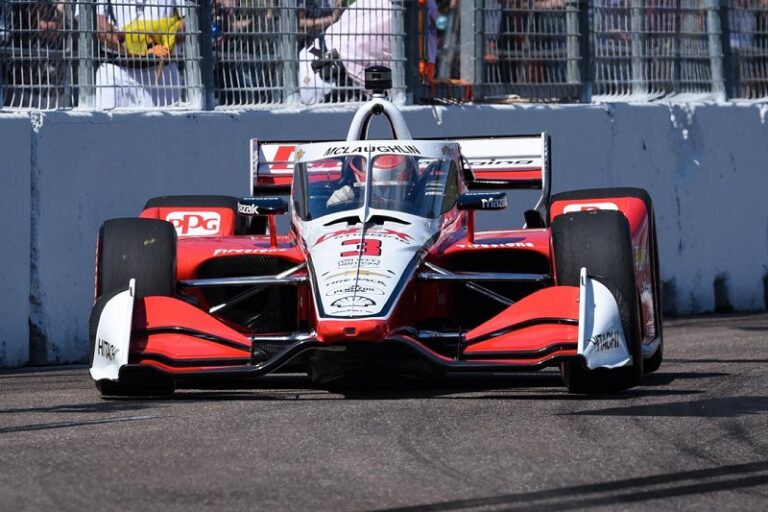Scott McLaughlin on Cornering at the Limit of Grip


Yes indeed. The multiple V8 Supercar Champion has won his first Indy Car Race!
In this post, see how Scott talks about how he corners the race car at the limit of grip and then also how he decides on the final balance he wants - when the car is quickest - the balance trade-off.
These quotes from Scott, interviewed by Auto Action in 2019 and Speedcafe in 2020, are solid gold in my opinion.
Here is Scott's interpretation of how he feels the balance of the car and the feedback he gives:
SCOTT McLAUGHLIN ON CORNERING AT THE LIMIT OF GRIP – 1ST SUPERCAR TEST, 2019
Here’s a quote from Scott McLaughlin, the 2018 and 2019 Australian V8 Supercar Champion. At the beginning of the 2019 season, Scott McLaughlin said in an interview with Auto Action magazine after his first time out in the brand new DJR Penske V8 Supercars Ford Mustang:
“You have to have a bit more give and take; so, I go ‘give me a bit more turn’ but then I get loose in the rear. So, then I go ‘I’ll give you some of that turn back and you give me some of that rear back.’ So, it’s a bit of a trade-off.”
Feeling the rotation of the chassis as you approach the limit of grip is central to getting the best out of the car. The rotation feeling may be interpreted by the driver as oversteer, but we know from our understanding of the vehicle dynamics, that the initial rotation while the tyres are still gripping the road is due to the rear tyre slip angles causing a tiny rotation of the chassis.
Note that the feeling is only in the oversteer direction. So, your response to not feeling the rotation as you expect, is to push harder until you do.
Detection of understeer is important here also. If you push with understeer, the understeer will get worse. Therefore, you need to manipulate the balance of the car (probably with more trail braking), so that you can get the car turned early (at the expense of some corner speed) and then get on the power early so you can negate the understeer on the corner exit. Set-up changes in the direction of oversteer are most probably required to restore driver feeling and to make the car fast.
SCOTT MCLAUGHLIN COMMENTS –
1ST PRACTICE AT THE MELBOURNE 400, 2020, (Before the meeting was cancelled due to Covid restrictions.)
Scott McLaughlin again, talking on set-up direction for his Mustang Supercar at the Melbourne 400, first drive with the 2020 spec car, as told to Speedcafe after the first day of practice (before the meeting was cancelled):
“I’ve got a very neutral car, so it’s frustrating trying to work out how to give Ludo and Richard (his engineers) feedback on what I want.
I don’t know if I want more turn or more drive and I don’t want to give away one for the other.”
Scott's comments inspired what we have called the "Balance Trade-off™", a procedure we recommend to all our clients, helping them with determining the balance they need.
For race cars without significant aero downforce:
Firstly, determine your baseline suspension set-up for springs and anti-roll bars, using our Racing Car Technology "Weight Transfer Worksheet™". Then in testing at the track, adjust the car to understeer first by stiffening up the front anti-roll bar. And then determine the final balance you prefer by stiffening the rear anti-roll bar, moving the balance of the car towards oversteer.
If you have a live rear axle car with adjustable height rear panhard bar or watts linkage, you can also final trim the car for more oversteer by adjusting the rear roll centre higher, if you have live rear axle with adjustable height panhard bar or watts linkage.
In both quotes, Scott is commenting on the car after his first drive in a new spec. Absolutely he will be looking to get the car balanced first and foremost. All the set-up work for geometry changes and other setting that can influence overall grip are pre-set in the workshop. It’s not clear whether there is time to test any changes, other than for balance before qualifying.
For owner/drivers testing their own race car, you can absolutely set up your suspension in the workshop with a balance for understeer/oversteer that is close to what you want. You also design the anti-roll bars with enough adjustment so you can fine tune the balance in a couple of sessions at the track.
The driver can’t really assess the grip unless they are doing a back-to-back test of something.
The driver’s sole focus in initial testing should be on balance, but grip still influences how the driver feels about the car.
In the first test of the new Mustang, compared to the previous year’s Ford Falcon, they were gaining more aero and subsequently the car felt good. In 2020, the rules mandated less aero. The reduced grip could have been an issue for Scott. Hence his indecision about the balance.
-------------------------------
Check out our car control and vehicle dynamics training for racing drivers:
"The Physics of Race Car Handling for Drivers"
Learn exactly what you are feeling and responding to as a racing driver.
And also,

